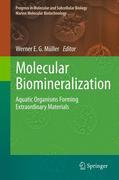
Molecular biomineralization: aquatic organisms forming extraordinary materials
Müller, Werner E.G.
The concept of ‘biomineralization’ signifies mineralization processes that take place in close association with organic molecules or matrices. The awareness that mineral formation can be guided by organic molecules notably contributed to the understanding of the formation of the inorganic skeletons of living organisms. Modern electron microscopic and spectroscopic analyses have successfully demonstrated the participation of biological systems in several mineralization processes, and prominent examples include the formation of bio-silica indiatoms and sponges. This insight has already made the application of recombinant technology for the production of valuable inorganic polymers, such as bio-silica, possible. This polymer can be formed by silicatein under conditions that cannot be matched by chemical means. Similarly, the efforts described in this book have elucidated that certain organisms, bacteria in deep-sea polymetallic nodules and coccoliths in seamount crusts, are involved in the depositionof marine minerals. Strategies have already been developed to utilize such microorganisms for the biosynthesis and bioleaching of marine deposits. Moreover, studies reveal that bio-polymers enhance the hydroxyapatite formation of bone-forming cells and alter the expression of important regulators of bone resorption, suggesting a potential for bone regeneration and treatment. prevention of osteoporosis. Written by leading experts in the field. State-of-the-art overview of all aspects of biomineralization. Includes outlook on future applications. INDICE: Magnetite Biomineralization in Bacteria. Maxi and Mini Ferritins: Minerals and Protein Nanocages. Manganese Oxidation by Bacteria: Biogeochemical Aspects. Molecular Biomineralization: Towards an Understanding of the Biogenic Origin of Polymetallic Nodules, Seamount Crusts and Hydrothermal Vents.- Molecular basis of bacterial calcium carbonate precipitation. Principles of calcium-based biomineralization. Molecular Aspects of Biomineralization of the Echinoderm Endoskeleton. Echinoderms as blueprints for biocalcification: regulation of skeletogenic genes and matrices. The unique invention of the siliceous sponges: their enzymatically made bio-silica skeleton. Biosilica-based strategies for treatment of osteoporosis and other bone diseases. Structure and function of matrix proteins and peptides in the biomineral formation in crustaceans.Molecular Approaches to Understand Biomineralization of Shell Nacreous Layer.Acidic shell proteins of the Mediterranean fan mussel Pinna nobili.
- ISBN: 978-3-642-21229-1
- Editorial: Springer Berlin Heidelberg
- Encuadernacion: Cartoné
- Páginas: 300
- Fecha Publicación: 01/09/2011
- Nº Volúmenes: 1
- Idioma: Inglés
